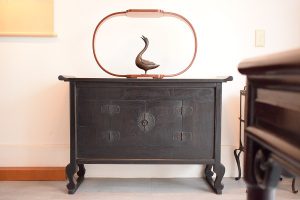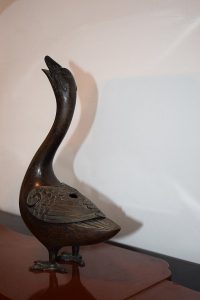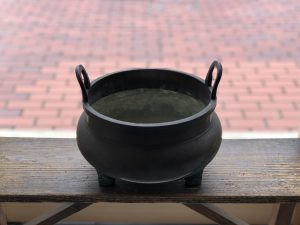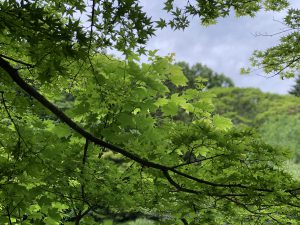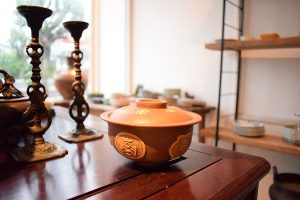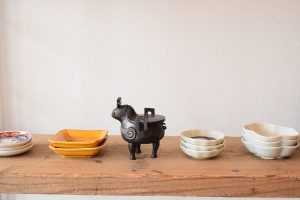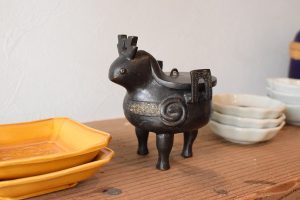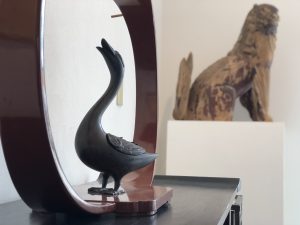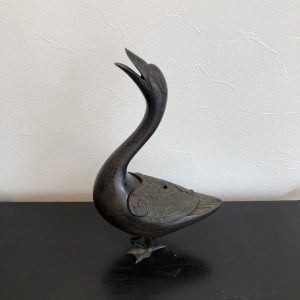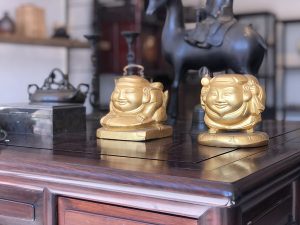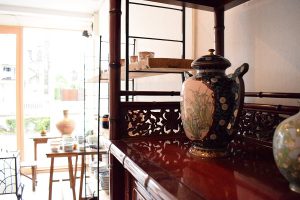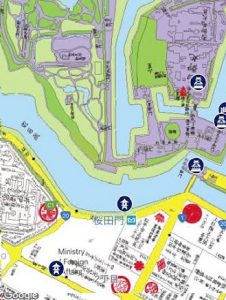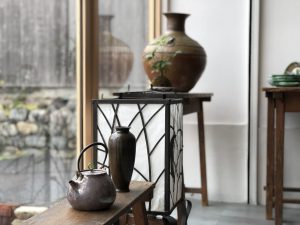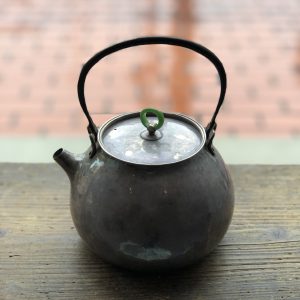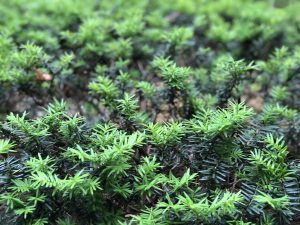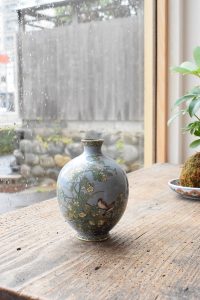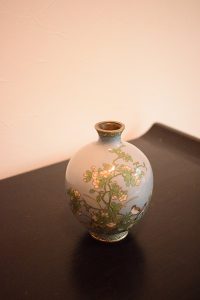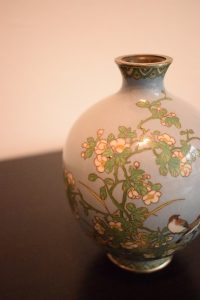熱田神宮の白蛇に遭遇?!(骨董買取いたします。愛知県名古屋市千種区 古美術風光舎 名古屋店)
2021.05.30
皆さま、初めまして。新しく入りました、神社大好きスタッフMです。どうぞよろしくお願い致します。
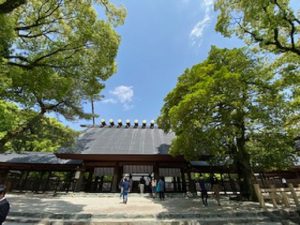
さて、梅雨の中休みの先日、普段からよく参拝する熱田神宮に行って参りました。熱田神宮ができたのはおよそ1900年前、三種の神器の一つである草薙の剣が祀られたことに始まります。日本でも有数の由緒正しい神社です。鳥居をくぐり、一歩参道に足を踏み入れると、前日の雨で清められた空間がとても心地よく、歩くだけで浄化されていく気分です。
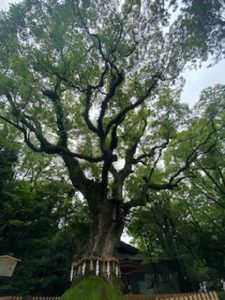
手水舎の横には、ひときわ存在感をはなつ大きな楠があります。これは、弘法大師がお手植えされたと言われる大楠で、樹齢1000年以上とも言われています。その周りで何やら人だかりが出来ていました。気にせず友人とおしゃべりに夢中になっていると、一人の方が「蛇が出たってよ。」と教えてくれました。その人だかりのところに行くと、タッチの差で蛇はいなくなってしまった様子です。

熱田神宮の大楠には昔から白蛇さんが住んでいて、もしそれが見られたら金運、開運アップと言われています。実際に大楠の前の賽銭箱の横にはいつも卵がお供えしてあります。ですが、何年も通っていても一度も見たことはないし、本当にいるのかしら?と思っていた私には驚きでした。実際には見られなかったけれども、確実にいることが証明された瞬間でした。近くにいた方が写真に収めていたので見せていただきました。すると本当に白い蛇でした。周りのおじ様方のお話によるとどうも、青大将なのだそうです。雨の次の晴れた日には見られるという貴重な情報までいただきました。変温動物の蛇さんは冷えた身体を太陽の熱で温めるのですね。他にも、いたるところに木のうろがあり、そこに自在に出入りしているらしい、白蛇さんは卵を丸呑みするんだ、しかも一個じゃなく五個も呑んだのを見たことがある、などなど。普通にお参りに行ったつもりが、思いがけず非日常の出来事と出会い、ワクワクと心躍るひとときとなりました。
白蛇は神様の使いといわれますし、蛇は龍の化身とも言われています。もともと日本には蛇を神様とする信仰がありましたが、中国から仏教が伝わると同時に龍信仰も伝わり、蛇と龍が同様に神様と扱われるようになりました。どちらも尊い存在だからこそ、いにしえから私たちの祖先は蛇や龍の置物を飾ったり、食器などにも蛇や龍を描き大切にしたのでしょうか。
あなたの暮らしにもそんな存在を感じてみてはいかがですか?
Nice to meet you, everyone. I’m M, a new staff member who loves shrines. Thank you for your cooperation.
By the way, the other day during the rainy season, I went to Atsuta Jingu, which I often visit. Atsuta Jingu was built about 1900 years ago when Kusanagi’s sword, one of the three sacred treasures, was enshrined. It is one of the most venerable shrines in Japan. After passing through the torii gate and stepping into the approach, the space that was cleansed by the rain the day before is very comfortable, and it feels like it will be purified just by walking.
Next to the Chozuya, there is a large camphor tree that stands out. This is Okusu, which is said to have been hand-planted by Kobo Daishi, and is said to be over 1000 years old. There was a crowd around it. When I was absorbed in chatting with my friends without worrying about it, one person told me, “A snake has come out.” When I went to the crowd, it seems that the snake disappeared due to the difference in touch.
Mr. White Snake has lived in Okusu at Atsuta Jingu for a long time, and if you can see it, it is said that your fortune and good luck will improve. In fact, eggs are always offered next to the offering box in front of Okusu. However, I have never seen it even after many years, and am I really there? I was surprised when I thought. It was a moment that proved to be certain, though it wasn’t actually seen. The person who was nearby took a picture, so I showed it. Then it was a really white snake. According to the stories of the uncles around him, he is a blue general. We also received valuable information that it can be seen on a sunny day after the rain. The poikilotherm snake warms his cold body with the heat of the sun. Besides, there are trees everywhere, and it seems that they can go in and out freely, Mr. White Snake swallows whole eggs, and I have seen five swallows instead of one. etc. I intended to go to visit normally, but unexpectedly I encountered an extraordinary event, and it was an exciting time.
The white snake is said to be a messenger of God, and the snake is also said to be an incarnation of a dragon. Originally, Japan had a belief that snakes were gods, but at the same time that Buddhism was transmitted from China, dragon beliefs were also transmitted, and snakes and dragons are now treated as gods as well. Because both are precious beings, did our ancestors decorate snakes and dragon figurines from ancient times, and cherish snakes and dragons on tableware?
Why don’t you feel such a presence in your life?
********************
生活様式の変化とともに、大切なお品を整理されている方も多いことと思われます。
ここ風光舎では、古美術品や骨董品の他にも絵画や宝石、趣味のお品など様々なジャンルのものを買受しております。
お片付けをされていて、こういうものでもいいのかしらと迷われているものでも、どうぞお気軽にご相談下さいませ。
風光舎は、出張買取も強化しております。
愛知県内はもちろん、岐阜県・三重県その他の県へも出張いたします。
どんなにご近所の方でもお伺いできますので、まずはお電話お待ちしております。
愛知県名古屋市千種区・骨董 買取『古美術 風光舎 名古屋店』
TEL:052-734-8444
********************
It seems that many people are organizing important items as their lifestyle changes.
Here at Fukosha, in addition to antiques and antiques, we also purchase paintings, jewelry, hobby items, and other genres.
Please feel free to contact us even if you have been tidied up and are wondering if this kind of thing is okay.
Fukosha is also strengthening business trip purchases.
We will make business trips not only to Aichi prefecture but also to Gifu prefecture, Mie prefecture and other prefectures.
No matter how close you are, we are looking forward to your call.
Chikusa-ku, Nagoya-shi, Aichi, antique purchase “Antique Fukosha Nagoya store”
TEL: 052-734-8444

